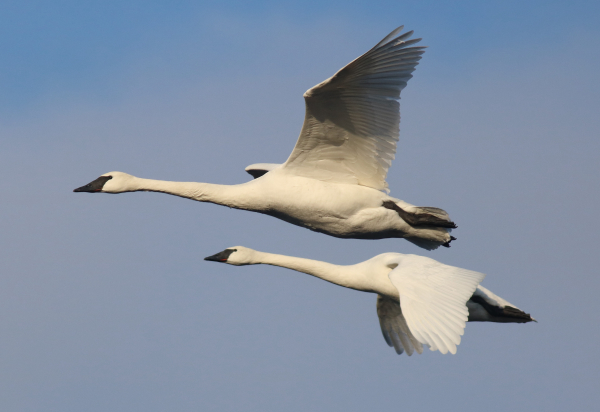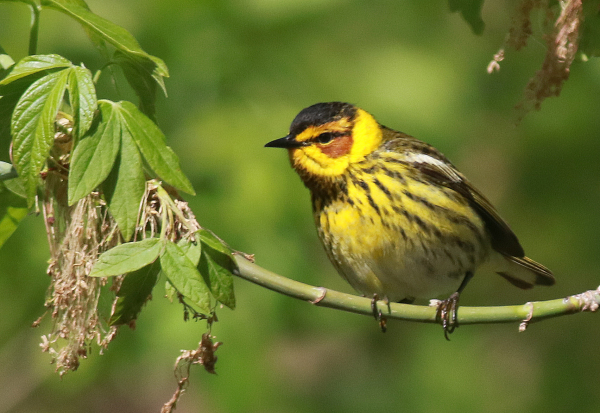
Trumpeter Swans are an example of short-distance migrants.

Many neotropical migrants, including Cape May Warblers, spend the winter in tropical areas that have ample foods, primarily insects, then migrate north to nesting areas in North America’s boreal forests to take advantage of less competition for abundant insect food and nesting sites during the northern spring and summer (photos by Paul Konrad).

Many species congregate in flocks during migration, such as these Western Sandpipers – especially at regular stopover locations where they feed and rest between migration flights.
|
We all enjoy the changing seasons, keeping lists of the species we see and waiting patiently for the return of migratory birds. Certainly, bird migrations dictate so much of our birding seasons – and our daily observations. Among the more than 650 species that nest in North America, more than half are migratory. But do you know why birds migrate, or how they navigate during migration? Let’s take a closer look at bird migration, and in the process you may even wish to learn more about where the birds you enjoy most spend their winters.
Birds migrate to move from areas of low or decreasing resources to areas of high or increasing resources. The two primary resources are food and nesting sites. Birds that nest in the Northern Hemisphere tend to migrate northward during spring to take advantage of burgeoning insect populations, increasing flowering plants, and an abundance of nesting locations. Conversely, as winter approaches and the availability of insects and other foods decline due to colder temperatures, birds move south again. Escaping the cold is a motivating factor but many species, including hummingbirds, can withstand slightly freezing temperatures as long as there is an adequate supply of food available.
While short-distance migration probably developed from a fairly simple need for food, the origins of long-distant migration patterns are much more complex. They’ve evolved over thousands of years and are controlled at least partly by the genetic makeup of bird species – that is, innate behavior. They also incorporate responses to weather, geography, food sources, day length, and other factors.
Why Do Some Birds Migrate? – For birds that spend winter in the tropics, it seems strange to imagine embarking on a migration north. Why do they make such an arduous trip north during spring? One theory is that through many many generations the tropical ancestors of these birds dispersed from their tropical nesting sites northward. The seasonal abundance of insect foods and longer day length allowed them to raise more young (4 to 6 average) than their non-migratory tropical “relatives” (2 to 3 average). As their nesting ranges shifted north during periods when continental glaciers were retreating northward, the birds continued to return to their tropical ranges as winter weather and declining food supplies made surviving more difficult or impossible. Supporting this theory is the fact that most vireos, flycatchers, tanagers, warblers, orioles, and swallows that nest in North America have evolved from ancestral birds that originated in the tropics.
The secrets of birds’ amazing navigational skills aren’t fully understood, partly because birds combine a number of senses when they navigate. Birds can get directional information from the sun, the stars, and by sensing the earth’s magnetic field. They also get information from the position of the setting sun and from geographic landmarks they see during the day, such as rivers and mountain ridges. There’s even evidence that sense of smell plays a role for some birds.
Some species, particularly waterfowl and cranes, follow preferred pathways during their annual migrations. These routes are often related to important stopover locations that provide food supplies critical to the birds’ survival during fall and nesting vigor during spring. Smaller birds tend to migrate in broad fronts across the landscape. Recent studies using eBird data are revealing that many small birds take different routes during spring and fall migrations to take advantage of seasonal patterns of weather and food availability. Without question, there are no simple answers to bird migration in such general terms, but migrations of a single species and individuals of that species is fascinating and we are learning more each year from scientific studies, and from the combined observations of citizen scientists.
Migration is a fascinating aspect of bird behavior and survival – one that scientists and birders alike continue to study and learn about. For more information about the basics of bird migration, you can review a variety of information sources, starting with https://www.allaboutbirds.org/news/the-basics-how-why-and-where-of-bird-migration/
Share your birding experiences and photos at editorstbw2@gmail.com